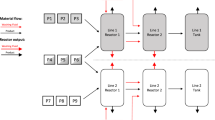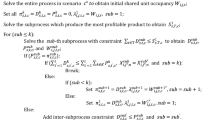Abstract
A mixed integer linear programming (MILP) for the detailed production planning of multiproduct batch plants is presented in this work. New timing decisions are incorporated to the model taking into account that an operation mode based in campaigns is adopted. This operation mode assures a more efficient production management adjusted to the specific context conditions of the considered time horizon. In addition, special considerations as sequence-dependent changeover times and different unit sizes for parallel units in each stage are taken into account. The problem consists of determining the amount of each product to be produced, stored and sold over the given time horizon, the composition of the production campaign (number of batches and their sizes), the assignment, sequencing and timing of batches, and the number of repetitions of the campaign, for a given plant with known product recipes. The objective is to maximize the net profit fulfilling the minimum and maximum product demands. The proposed model provides a useful tool for solving the optimal campaign planning of installed facilities in reasonable computation time, taking different decisions about the operations management.




Similar content being viewed by others
Abbreviations
- \(b, b'\) :
-
Batch
- \(i, i'\) :
-
Product
- j :
-
Stage
- k :
-
Unit
- \(l, l'\) :
-
Slot
- m :
-
Index utilized for the representation in base 2 for the number of repetition of the campaign
- r :
-
Raw material
- I :
-
Products
- \({ IB}_{i}\) :
-
Admitted batches of product i in the campaign composition
- \(K_{j}\) :
-
Nonidentical parallel batch unit that operate out-of-phase in stage j
- \(B_i^{{ max} } \) :
-
Maximum feasible batch size for product i
- \(B_i^{{ min} } \) :
-
Minimum feasible batch size for product i
- \(c_{ii^{\prime }k}\) :
-
Sequence-dependent changeover time between products i and \(i'\) at unit k
- \({ co}_{i}\) :
-
Operating cost coefficient of product i
- \({ DE}_i^L\) :
-
Minimum demand of product i
- \({ DE}_i^U \) :
-
Maximum demand of product i
- \(F_{ri}\) :
-
Raw material conversion factor
- H :
-
Planning horizon
- \({ IMinit}_{r}\) :
-
Inventory of raw material r at the beginning of planning horizon
- \({ IPinit}_{i}\) :
-
Inventory of product i at the beginning of planning horizon
- L :
-
Number of slots postulated for all units of each stage
- \(M_{b}\) :
-
Big-M constant parameters for b = 1, 2, 3, 4
- \({ np}_{i}\) :
-
Selling price of product i
- \(NBC_i^{{ UP}} \) :
-
Maximum number of batches of product i in the campaign
- \({ NC}^{{ UP}} \) :
-
Maximum number of times that the campaign can be repeated over the planning horizon
- \(Q_i^L \) :
-
Lower bound for production level of product i
- \(Q_i^U \) :
-
Upper bound for production level of product i
- \({ SF}_{ij}\) :
-
Size factor of product i in stage j
- \(t_{ik}\) :
-
Processing time of product i in batch unit k
- \(V_{k}\) :
-
Size of unit k
- \(\alpha _{ik}\) :
-
Equipment utilization minimum rate for product i at unit k
- \(\beta _{r}\) :
-
Inventory cost coefficient for raw material r
- \(\delta _{i}\) :
-
Inventory cost coefficient for product i
- \(\kappa _{r}\) :
-
Price of raw material r
- \(\lambda \) :
-
Weighting factor for the variable CT in the objective function
- \(x_{m}\) :
-
Variable utilized for the representation in base 2 for the number of campaign repetition
- \(X_{kl}\) :
-
Indicates if slot l of unit k is employed
- \(Y_{bkl}\) :
-
Indicates if batch b is assigned to slot l of unit k
- \(z_{ib}\) :
-
Indicates if batch b of product i is selected
- \(B_{ib}\) :
-
Size of batch b of product i
- \({ CR}_{r}\) :
-
Amount of raw material r purchased during the planning horizon
- CT :
-
Campaign cycle time
- \({ IM}_{r}\) :
-
Inventory of raw material r at the end of the time horizon
- \({ IP}_{i}\) :
-
Inventory of final product i at the end of the time horizon
- \({ NB}_{it}\) :
-
Total number of batches of product i processed in the time horizon
- \({ NBC}_{i}\) :
-
Number of batches of product i included in the campaign
- NC :
-
Number of times that the campaign is cyclically repeated over the time horizon
- NP :
-
Net profit
- \(Q_{i}\) :
-
Amount of product i to be produced in the planning horizon
- \({ QS}_{i}\) :
-
Amount of product i sold at the end of the planning horizon
- \({ RM}_{r}\) :
-
Amount of raw material r used for producing of all products during the time horizon
- \({ RM}_{ri}\) :
-
Amount of raw material r used to make product i
- \({ TF}_{kl}\) :
-
Final processing time of slot l in unit k for the first campaign cycle
- \({ TI}_{kl}\) :
-
Initial processing time of slot l in unit k for the first campaign cycle
- \(w_{ibm}\) :
-
Variable that represents the product \(B_{ib} \quad x_{m}\)
- \({ww}_{m}\) :
-
Variable that represents the product \({ CT x}_{m}\)
- \({YY}_{blb^{\prime }l^{\prime }k}\) :
-
Continuous variable on interval [0, 1] that indicates if batch b is assigned to slot l of unit k and batch \(b'\) to slot \(l'\) of the same unit
References
Berning, G., Brandenburg, M., Gursoy, K., Kussi, J. S., Mehta, V., & Tolle, F. J. (2004). Integrating collaborative planning and supply chain optimization for the chemical process industry I. Methodology. Computers & Chemical Engineering, 28, 913–927.
Bilgen, B., & Çelebi, Y. (2013). Integrated production scheduling and distribution planning in dairy supply chain by hybrid modeling. Annals of Operations Research, 211, 55–82.
Birewar, D. B., & Grossmann, I. E. (1989). Incorporating scheduling in the optimal design of multiproduct batch plants. Computers and Chemical Engineering, 13(1–2), 141–161.
Brooke, A., Kendrick, D., Meeraus, A., & Raman, R. (2012). GAMS, a user’s guide. Washington, DC: GAMS Development Corporation.
Chu, Y., You, F., Wassick, J. M., & Agarwal, A. (2015). Integrated planning and scheduling under production uncertainties: Bi-level model formulation and hybrid solution method. Computers and Chemical Engineering, 72, 255–272.
Coban, E., & Hooker, J. (2013). Single-facility scheduling by logic-based Benders decomposition. Annals of Operations Research, 210, 245–272.
Erdirik-Dogan, M., & Grossmann, I. E. (2006). A decomposition method for the simultaneous planning and scheduling of single-stage continuous muliproduct plants. Industrial and Engineering Chemistry Research, 45, 299–315.
Erdirik-Dogan, M., & Grossmann, I. E. (2008). Simultaneous planning and scheduling of single-stage multi-product continuous plants with parallel lines. Computers and Chemical Engineering, 32, 2664–2683.
Fumero, Y., Corsano, G., & Montagna, J. M. (2011). Detailed design of multiproduct batch plants considering production scheduling. Industrial and Engineering Chemistry Research, 50, 6146–6160.
Fumero, Y., Corsano, G., & Montagna, J. M. (2012a). Planning and scheduling of multistage multiproduct batch plants operating under production campaigns. Annals of Operations Research, 199, 249–268.
Fumero, Y., Corsano, G., & Montagna, J. M. (2012b). Scheduling of multistage multiproduct batch plants operating in a campaign-mode. Industrial and Engineering Chemistry Research, 51, 3988–4001.
Fumero, Y., Corsano, G., & Montagna, J. M. (2014). Simultaneous batching and scheduling of batch plants that operate in a campaign-mode, considering nonidentical parallel units and sequence-dependent changeovers. Industrial and Engineering Chemistry Research, 53(44), 17059–17074.
Glover, F. (1975). Improved linear integer programming formulations of nonlinear integer problems. Management Science, 22, 455–460.
Grossmann, I. E., Van den Heever, S. A., & Harjunkoski, I. (2002). Discrete optimization methods and their role in the integration of planning and scheduling. AIChE Symposium Series, 98, 150–168.
Kallrath, J. (2002). Planning and scheduling in the process industry. OR Spectrum, 24, 219–250.
Li, Z., & Ierapetritou, M. G. (2009). Integrated production planning and scheduling using a decomposition framework. Chemical Engineering Science, 64, 3585–359.
Liu, S., Pinto, J. M., & Papageorgiou, L. G. (2010). MILP-based approaches for medium-term planning of single-stage continuous multiproduct plants with parallel units. Computational Management Science, 7, 407–435.
Maravelias, C. T., & Sung, C. (2009). Integration of production planning and scheduling: Overview, challenges and opportunities. Computers and Chemical Engineering, 33, 1919–1930.
Marchetti, P. A., Méndez, C. A., & Cerdá, J. (2010). Mixed-integer linear programming monolithic formulations for lot-sizing and scheduling of single-stage batch facilities. Industrial and Engineering Chemistry Research, 49, 6482–6498.
Marchetti, P. A., Méndez, C. A., & Cerdá, J. (2012). Simultaneous lot sizing and scheduling of multistage batch processes handling multiple orders per product. Industrial and Engineering Chemistry Research, 51, 5762–5780.
Prasad, P., & Maravelias, C. T. (2008). Batch selection, assignment and sequencing in multi-stage multi-product processes. Computers and Chemical Engineering, 32, 1106–1119.
Reklaitis, G. V. (2000). Overview of planning and scheduling technologies. Latin American Applied Research, 30(4), 285–293.
Shah, N. (1998). Single and multisite planning and scheduling: Current status and future challenge. In J. F. Pekny & G. E. Blau (Eds.), Proceedings of the third international conference of the foundations of computer-aided process operations (pp. 75–90). Utah: Snowbird.
Shao, X. Y., Li, X. Y., Gao, L., & Zhang, C. Y. (2009). Integration of process planning and scheduling—a modified genetic algorithm-based approach. Computers & Operations Research, 36, 2082–2096.
Sundaramoorthy, A., Maravelias, C. T., & Prasad, P. (2009). Scheduling of multistage batch processes under utility constraints. Industrial and Engineering Chemistry Research, 48, 6050–6058.
Sundaramoorthy, A., & Maravelias, C. T. (2008a). Simultaneous batching and scheduling in multistage multiproduct processes. Industrial and Engineering Chemistry Research, 47, 1546–1555.
Sundaramoorthy, A., & Maravelias, C. T. (2008b). Modeling of storage in batching and scheduling of multistage processes. Industrial and Engineering Chemistry Research, 47, 6648–6660.
Voudouris, V. T., & Grossmann, I. E. (1992). Mixed-integer linear programming reformulations for batch process design with discrete equipment sizes. Industrial and Engineering Chemistry Research, 31, 1315–1325.
Yan, H. S., & Zhang, X. D. (2007). A case study on integrated production planning and scheduling in a three stage manufacturing system. IEEE Transactions on Automation Science and Engineering, 4(1), 86–92.
Acknowledgments
The authors appreciate the financial support from Consejo Nacional de Investigaciones Científicas y Técnicas (CONICET) and Agencia Nacional de Promoción Científica y Tecnológica (ANPCyT) from Argentina.
Author information
Authors and Affiliations
Corresponding author
Rights and permissions
About this article
Cite this article
Fumero, Y., Corsano, G. & Montagna, J.M. An MILP model for planning of batch plants operating in a campaign-mode. Ann Oper Res 258, 415–435 (2017). https://doi.org/10.1007/s10479-016-2301-6
Published:
Issue Date:
DOI: https://doi.org/10.1007/s10479-016-2301-6




